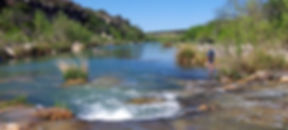Worst Drought since the 50s
Llano News-June 22, 2011 Tyson Broad
Will the Llano River soon cease to flow? If the past can predict the future, the answer is “probably yes”.
The last time zero flow was recorded at the US Geological Survey (USGS) gauge at Llano was on July 20 and 21, 1984. Twenty years before that, zero flow was recorded for 19 days in July, 1964. The flow on June 22 in those years was 23 cubic feet per second (cfs), compared to the 3 cfs currently in the river. (A cubic foot is about 7.5 gallons)
This spring’s record heat and wind certainly have had an impact on flows, but so have drought conditions for three of the last four years. On average, the annual flow of the Llano River at Llano is 382 cfs. Since 2008, the flow has been 54 percent of average (205 cfs). The last time the four-year average was this low was during the drought of the fifties.
To date, the current drought has yet to reach the magnitude and length of the drought of the fifties. Average annual flow during a seven-year period from 1950-56 was 44 percent of average. For 67 days, from June 25th to August 30th of 1956, the Llano River ceased to flow and water was brought in by railcar to the city.
During drought, most of the flow in the Llano River is from springs on the South Llano River. One of the largest of these springs is Seven Hundred Springs. On June 2, 2011, USGS measured the flow at 13.6 cfs, similar to the springflow in 1964 and 1984. During the fifties drought, springflows were reported to be 11 cfs.
In Junction, records dating back to 1915 show the river has never ceased to flow. During the height of the drought in 1956, the flow of the Llano River at Junction was 3.7 cfs. Currently, the flow is 43 cfs, similar to the flow recorded on this date in 1964.
Hydrologic records for Llano, Seven Hundred Springs, and Junction all suggest that the current drought is the worse since the drought of the fifties.
Accurately predicting what happens next is based on many variables. The seasonal outlook from the National Weather Service predicts persistent drought through September, but also predicts an above-normal hurricane season.
The El Nino-La Nina cycle is another variable. Fortunately, the current La Nina, which has brought drought conditions, is predicted to continue to weaken. Unfortunately, it usually takes at least a year for an El Nino episode to form in its place. The last two El Nino periods in 2007 and 2009 broke drought conditions across the region.
Predicting hydrologic conditions is not an exact science and is based on many variables. However, current conditions and predictions indicate that it may be a long summer.
Update June 29, 2011
Rains across the watershed last Tuesday night (June 21) have boosted the flow at Llano to 15 cfs. On this date in 1980, flows were 17 cfs and in 1964, were 9 cfs.
Flows in Junction are 42 cfs. In 1984, flows for the Llano at Junction were 54 cfs.; in 1964, flows were 40 cfs.
Similar to Llano River @Llano, the four-year average flow for Llano River @ Junction is 57% percent of normal. Average annual flow is 198 cfs. The last time it was this low was at the end of the drought of the 50s.




